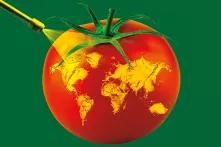
Parts of global crop production are lost to pests and plant pathogens each year. Pesticides have been designed to prevent these yield losses – but they also give rise to new problems.

Grave famines and economic upheavals resulting from crop failures have occurred throughout history. People have always fought against this existential challenge – for example by using certain cultivation methods and certain crop rotations to avoid weeds and pests. The industrial revolution saw the emergence of the first synthetic chemical pesticides: They were meant to protect crops and reduce workloads. Starting in the 1940s, the chemical industry began marketing broad-spectrum pesticides – they were poisonous to entire groups of organisms and initially proved to be much more effective compared to previously available substances. Global pesticide use has continued to grow steadily for decades: Between 1990 and 2017 by about 80 percent.* The interplay of pesticides, fertilizers and technological progress led to a fundamental change of agricultural production. As farmers now kept diseases and pests at bay through pesticides rather than crop rotations and crop combinations, monocultures of single crops repeatedly grown on the same land became the standard. As a result, today’s industrial agriculture is dependent on pesticides and is largely unimaginable without them. Capital-intensive inputs increased yields in many industrialized countries since the 1950s. Therefore, the supply of agricultural products grew much faster than the demand; a development that has resulted in lower prices for agricultural products, which become cheaper and cheaper, while wages for farmers and agricultural workers have decreased. Not only has the amount of pesticides applied worldwide increased, but so has the scientific research on pesticide effects – experts have gained more and more knowledge about how pesticides can affect human health and pollute the environment.
Today, pesticide consumption worldwide stands at 4 million tonnes globally. Half of the substances applied are herbicides, which are used against weeds; about 30 percent are insecticides, which are used against insects that can harm harvests. And about 17 percent are fungicides against fungal infestation. The global pesticides market size reached a value of nearly 84.5 billion US dollars in 2019, with an annual growth rate of more than 4 percent since 2015. In the next few years, the rate of growth could increase further. By 2023, the total value of all pesticides used is expected to grow at a rate of 11.5 percent to nearly 130.7 billion US dollars. Many factors, like soil degradation and biodiversity loss, have contributed to the increase. The climate crisis can be another driver for pesticide use. A study from the US-American Seattle University found: Insect activity in crop-growing regions will rise along with temperatures. This will boost losses of rice, maize and wheat by 10–25 percent for each degree Celsius that temperatures rise. There are major reasons for this. For example, climate crisis is altering pest populations and the ratio of pests to beneficial insects. Insects seek out conditions that suit them and move to new areas that lack their natural enemies. This will cause their populations to grow, resulting in more crop damage. Furthermore, the plants’ natural potential to resist to pests decreases as a result of climate-related stress.
Depending on the region and the phase of industrial development, usage of pesticides is associated with different intensity. The 1960s are considered the age of the “Green Revolution” that was devised to increase agricultural production, particularly in the Global South – through the use of pesticides, fertilizers, high-yield crops and irrigation. In retrospect, civil society organizations and scientists view the “Green Revolution” as the beginning of a failed agricultural development, which led many farmers into desperate situations.
Many people in the Global South have gone into debt to buy expensive means of production. Due to high profit margins and insufficient government regulation, the trade in illicit pesticides has increased over recent years. And the sale of counterfeit pesticides has become a profitable business as well: In the first four months of 2020, illegal pesticides worth up to 94 million euros were seized in the EU and six other non-EU countries such as Colombia, Switzerland and the USA. The use of such pesticides puts farmers at particular risk because the ingredients and their concentrations may be misstated or misrepresented – making their effects and toxicity unpredictable.
Pesticides do not stay where they have been applied. They contaminate the environment and contribute to an imbalance in the ecosystem. New research shows that pesticides even contribute to pollution with microplastics when active ingredients are intentionally encapsulated for slower release. A key challenge for governments is to inform farmers worldwide about the dangers of pesticides, to take measures to protect them and to enable manageable crop protection alternatives to chemical pest control. Ideas on how this could work abound, although research in topics such as ecologically-based pest management remains underfunded.
* FAO statistical yearbook 2021, https://bit.ly/3Nl7tsx. After the launch of the first edition of this publication, the FAO numbers were revised retrospectively.

